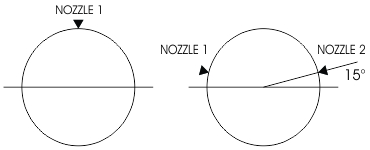 An effective Spark detection system must monitor all potential paths of a spark or ember through all branches of ducts and once a spark or ember is detected, it must establish a curtain of water through which the spark must pass. Each main duct system is considered a protection zone. If your dust collector has a single main duct, then only one zone is required.
An effective Spark detection system must monitor all potential paths of a spark or ember through all branches of ducts and once a spark or ember is detected, it must establish a curtain of water through which the spark must pass. Each main duct system is considered a protection zone. If your dust collector has a single main duct, then only one zone is required.
The air in the ducts is travelling at a very great rate of speed and therefore carries a spark or ember very rapidly. Air transport speeds of 6000 ft/min. are not uncommon which means a spark can be carried 100 feet in one second. Detecting the spark, turning on the water and establishing a spray curtain across the entire duct can take as much .288 seconds or .0048 minutes. If the spark is travelling a 100 feet per second, we will therefore require the detector to be placed at least 28.8 feet ahead of the water spray nozzle since that is how far the spark will travel in .288 seconds. If there is insufficient length available on the main duct, detectors can be placed on the branch lines or the main duct must be extended.

AIR VELOCITY
The air velocity must be greater than 500 feet per minute and less than 10,000 feet per minute to ensure proper operation and detection. The air velocity is generally known prior to installation but Hansentek highly recommends that the air velocity be measured and confirmed prior to installation. If the air velocity is not known, you can simply calculate the velocity based on the dust collector capacity and the size of the duct (area of a cross section of the duct).
| Velocity(V) = | CUBIC FEET PER MINUTE (CFM) |
| AREA OF DUCT IN SQ. FT (A) |
The diameter of a circular duct can be calculated by dividing the circumference by p which is the equivalent of 3.1416. The following table provides the area in feet of a cross section of various size ducts. If you are not sure of the duct size, you can measure the circumference and use that column of the table:
|
DUCT SIZE |
DUCT CIRCUMFERENCE |
AREA (SQ.FT) |
|
8 inches |
25.13 inches |
.3491 Square Feet |
|
10 inches |
31.42 inches |
.5454 Square Feet |
|
12 inches |
37.70 inches |
.7854 Square Feet |
|
14 inches |
43.98 inches |
1.069 Square Feet |
|
16 inches |
50.26 inches |
1.396 Square Feet |
|
18 inches |
56.55 inches |
1.767 Square Feet |
|
20 inches |
62.83 inches |
2.182 Square Feet |
|
22 inches |
69.11 inches |
2.640 Square Feet |
|
24 inches |
75.40 inches |
3.142 Square Feet |
|
26 inches |
81.68 inches |
3.687 Square Feet |
|
28 inches |
87.96 inches |
4.276 Square Feet |
|
30 inches |
94.25 inches |
4.909 Square Feet |
|
32 inches |
100.5 inches |
5.585 Square Feet |
|
34 inches |
106.8 inches |
6.305 Square Feet |
|
36 inches |
113.1 inches |
7.069 Square Feet |
|
38 inches |
119.4 inches |
7.876 Square Feet |
|
40 inches |
125.7 inches |
8.727 Square Feet |
|
42 inches |
131.9 inches |
9.621 Square Feet |
|
44 inches |
138.2 inches |
10.56 Square Feet |
|
46 inches |
144.5 inches |
11.54 Square Feet |
|
48 inches |
150.8 inches |
12.57 Square Feet |
DETECTOR LOCATION
 The Hansentek detectors react very quickly to sparks and embers and therefore, the water spray pattern is established very quickly. The most significant delay in entire system is the reaction time of the water solenoid valve and the time it takes for the water spray to provide a curtain across the entire duct. The time it takes for the solenoid valve to open introduces the largest delay. There are a number of factors which effect the solenoid such as water pressure and mechanical variations in the valve itself. Since these factors are variable, we must allow the maximum time in our calculations to ensure the curtain of water is fully developed before the spark arrives.
The Hansentek detectors react very quickly to sparks and embers and therefore, the water spray pattern is established very quickly. The most significant delay in entire system is the reaction time of the water solenoid valve and the time it takes for the water spray to provide a curtain across the entire duct. The time it takes for the solenoid valve to open introduces the largest delay. There are a number of factors which effect the solenoid such as water pressure and mechanical variations in the valve itself. Since these factors are variable, we must allow the maximum time in our calculations to ensure the curtain of water is fully developed before the spark arrives.
The various maximum delay factors involved are:
- detector response time: 60 usec
- micro-processor sampling cycle: 20 msec
- assembly opening time: 200 msec
- water spray traverse time of the duct: 68 msec
The Total System Reaction time is thus .288 seconds or .0048 minutes.
With a known velocity we simply calculate the distance ahead of the spray for placement of the detectors using the formula:
Distance (Ds) = Total System Reaction Time (Tr) X Velocity (V)
For example, with a velocity of 5000ft per minute, we require the detectors to be placed .0048 X 5000 = 24 Feet ahead of the water spray.
The following table provides various calculated values:
|
Velocity |
Distance (Ds) |
|
3000 ft/min |
14.4 feet |
|
3500 ft/min |
16.8 feet |
|
4000 ft/min |
19.2 feet |
|
4500 ft/min |
21.6 feet |
|
5000 ft/min |
24 feet |
|
5500 ft/min |
26.4 feet |
|
6000 ft/min |
28.8 feet |
|
6500 ft/min |
31.2 feet |
|
7000 ft/min |
33.6 feet |
|
7500 ft/min |
36 feet |
Detectors should not be located close to branch lines or they will become obscured by dust due to turbulent air flow. Detectors must be placed 2.5 X last branch diameter down stream from that branch (Db).
NUMBER OF DETECTORS
The number of detectors on any given main duct or branch line is determined by of the duct. Normally round ducts only require two detectors, one on each side of the duct. If the duct diameter is greater than 44″, then four detectors are required and situated as shown below. The detectors must be mounted opposite each other in the same vertical plane in order to perform their required sensitivity testing function. NEVER MOUNT A DETECTOR ON THE BOTTOM OF A DUCT.

The number of detectors in a square duct can be determined by using the simple ratio of Height to Width formulas detailed below. Note: MAX DIMENSIONS FOR WIDTH OR HEIGHT ARE 50″
Detector ratio formulas:
Where H/W < 1.7: two detectors are required
Where 1.7< H/W: four detectors required.
Note: For Installations using detectors that are not opposite each other, Sensitivity Checking cannot be done.
NUMBER OF SPRAY ASSEMBLIES
The number of nozzles required is a function of both the duct size and air speed. Normally, only one spray nozzle is required but for ducts larger than 39 inches, multiple nozzles are needed.
NUMBER OF SPRAY ASSEMBLIES NEEDED:
- Up to a 39″ diameter duct with maximum air velocity of 4500 ft/min: 1 spray assembly
- Up to a 39″ diameter duct with 4500 ft/min<air velocity<5500 ft/min: 2 spray assemblies
- From a 40″ to 42″ diameter duct with a maximum air velocity of 4500 ft/min: 2 spray assemblies
- From a 43″ to 46″ diameter duct with a maximum air velocity of 4500 ft/min: 3 spray assemblies
(for other diameters and air velocities not listed please consult Hansentek)
PLACEMENT OF SPRAY ASSEMBLIES
The Spray Assembly must be mounted on the top of the Duct and a proper distance away from any elbows (Dc). If two spray assemblies are required, they should be mounted as shown in order to allow the nozzle to properly drain. All nozzles must be mounted in the same plane of vertical circumference.

The nozzles must have straight ducts (constant diameter) past their placement in order to guarantee a proper cone of spray. The distance that the spray assembly must be maintained from any elbow is a function of the air velocity. Minimum distance to the closest bend is calculated as (Dc)=0.00113 X velocity of air flow (in feet per minute). The factor is .00113 times the velocity. Therefore if velocity is 5000 ft/min, the minimum distance of separation is .00113 X 5000 = 5.65 feet.
Water pipe, strainers, valves and nozzles installed outside must be heat traced and insulated. Heat tracing and insulation must be adequate to withstand the temperature extremes and environmental conditions of the area where it is installed.

